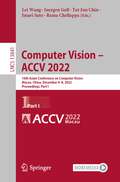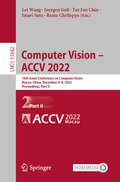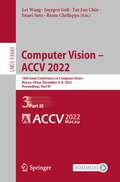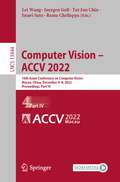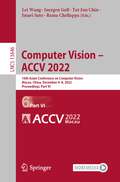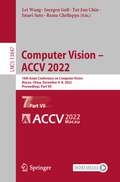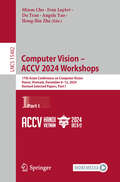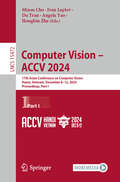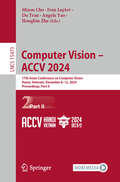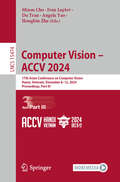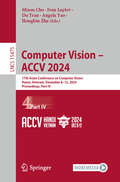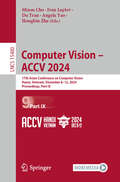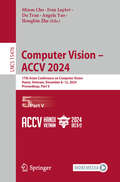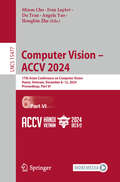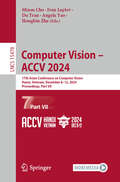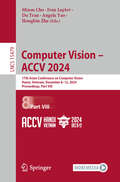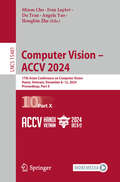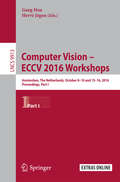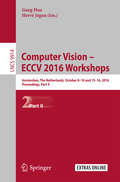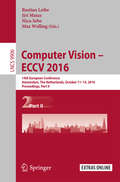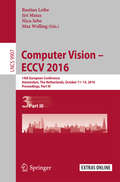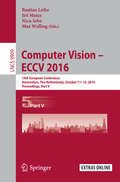- Table View
- List View
Computer Vision – ACCV 2022: 16th Asian Conference on Computer Vision, Macao, China, December 4–8, 2022, Proceedings, Part I (Lecture Notes in Computer Science #13841)
by Juergen Gall Rama Chellappa Lei Wang Imari Sato Tat-Jun ChinThe 7-volume set of LNCS 13841-13847 constitutes the proceedings of the 16th Asian Conference on Computer Vision, ACCV 2022, held in Macao, China, December 2022. The total of 277 contributions included in the proceedings set was carefully reviewed and selected from 836 submissions during two rounds of reviewing and improvement. The papers focus on the following topics: Part I: 3D computer vision; optimization methods; Part II: applications of computer vision, vision for X; computational photography, sensing, and display; Part III: low-level vision, image processing; Part IV: face and gesture; pose and action; video analysis and event recognition; vision and language; biometrics; Part V: recognition: feature detection, indexing, matching, and shape representation; datasets and performance analysis; Part VI: biomedical image analysis; deep learning for computer vision; Part VII: generative models for computer vision; segmentation and grouping; motion and tracking; document image analysis; big data, large scale methods.
Computer Vision – ACCV 2022: 16th Asian Conference on Computer Vision, Macao, China, December 4–8, 2022, Proceedings, Part II (Lecture Notes in Computer Science #13842)
by Juergen Gall Rama Chellappa Lei Wang Imari Sato Tat-Jun ChinThe 7-volume set of LNCS 13841-13847 constitutes the proceedings of the 16th Asian Conference on Computer Vision, ACCV 2022, held in Macao, China, December 2022. The total of 277 contributions included in the proceedings set was carefully reviewed and selected from 836 submissions during two rounds of reviewing and improvement. The papers focus on the following topics: Part I: 3D computer vision; optimization methods; Part II: applications of computer vision, vision for X; computational photography, sensing, and display; Part III: low-level vision, image processing; Part IV: face and gesture; pose and action; video analysis and event recognition; vision and language; biometrics; Part V: recognition: feature detection, indexing, matching, and shape representation; datasets and performance analysis; Part VI: biomedical image analysis; deep learning for computer vision; Part VII: generative models for computer vision; segmentation and grouping; motion and tracking; document image analysis; big data, large scale methods.
Computer Vision – ACCV 2022: 16th Asian Conference on Computer Vision, Macao, China, December 4–8, 2022, Proceedings, Part III (Lecture Notes in Computer Science #13843)
by Juergen Gall Rama Chellappa Lei Wang Imari Sato Tat-Jun ChinThe 7-volume set of LNCS 13841-13847 constitutes the proceedings of the 16th Asian Conference on Computer Vision, ACCV 2022, held in Macao, China, December 2022. The total of 277 contributions included in the proceedings set was carefully reviewed and selected from 836 submissions during two rounds of reviewing and improvement. The papers focus on the following topics: Part I: 3D computer vision; optimization methods; Part II: applications of computer vision, vision for X; computational photography, sensing, and display; Part III: low-level vision, image processing; Part IV: face and gesture; pose and action; video analysis and event recognition; vision and language; biometrics; Part V: recognition: feature detection, indexing, matching, and shape representation; datasets and performance analysis; Part VI: biomedical image analysis; deep learning for computer vision; Part VII: generative models for computer vision; segmentation and grouping; motion and tracking; document image analysis; big data, large scale methods.
Computer Vision – ACCV 2022: 16th Asian Conference on Computer Vision, Macao, China, December 4–8, 2022, Proceedings, Part IV (Lecture Notes in Computer Science #13844)
by Juergen Gall Rama Chellappa Lei Wang Imari Sato Tat-Jun ChinThe 7-volume set of LNCS 13841-13847 constitutes the proceedings of the 16th Asian Conference on Computer Vision, ACCV 2022, held in Macao, China, December 2022. The total of 277 contributions included in the proceedings set was carefully reviewed and selected from 836 submissions during two rounds of reviewing and improvement. The papers focus on the following topics: Part I: 3D computer vision; optimization methods; Part II: applications of computer vision, vision for X; computational photography, sensing, and display; Part III: low-level vision, image processing; Part IV: face and gesture; pose and action; video analysis and event recognition; vision and language; biometrics; Part V: recognition: feature detection, indexing, matching, and shape representation; datasets and performance analysis; Part VI: biomedical image analysis; deep learning for computer vision; Part VII: generative models for computer vision; segmentation and grouping; motion and tracking; document image analysis; big data, large scale methods.
Computer Vision – ACCV 2022: 16th Asian Conference on Computer Vision, Macao, China, December 4–8, 2022, Proceedings, Part V (Lecture Notes in Computer Science #13845)
by Juergen Gall Rama Chellappa Lei Wang Imari Sato Tat-Jun ChinThe 7-volume set of LNCS 13841-13847 constitutes the proceedings of the 16th Asian Conference on Computer Vision, ACCV 2022, held in Macao, China, December 2022. The total of 277 contributions included in the proceedings set was carefully reviewed and selected from 836 submissions during two rounds of reviewing and improvement. The papers focus on the following topics: Part I: 3D computer vision; optimization methods; Part II: applications of computer vision, vision for X; computational photography, sensing, and display; Part III: low-level vision, image processing; Part IV: face and gesture; pose and action; video analysis and event recognition; vision and language; biometrics; Part V: recognition: feature detection, indexing, matching, and shape representation; datasets and performance analysis; Part VI: biomedical image analysis; deep learning for computer vision; Part VII: generative models for computer vision; segmentation and grouping; motion and tracking; document image analysis; big data, large scale methods.
Computer Vision – ACCV 2022: 16th Asian Conference on Computer Vision, Macao, China, December 4–8, 2022, Proceedings, Part VI (Lecture Notes in Computer Science #13846)
by Juergen Gall Rama Chellappa Lei Wang Imari Sato Tat-Jun ChinThe 7-volume set of LNCS 13841-13847 constitutes the proceedings of the 16th Asian Conference on Computer Vision, ACCV 2022, held in Macao, China, December 2022. The total of 277 contributions included in the proceedings set was carefully reviewed and selected from 836 submissions during two rounds of reviewing and improvement. The papers focus on the following topics: Part I: 3D computer vision; optimization methods; Part II: applications of computer vision, vision for X; computational photography, sensing, and display; Part III: low-level vision, image processing; Part IV: face and gesture; pose and action; video analysis and event recognition; vision and language; biometrics; Part V: recognition: feature detection, indexing, matching, and shape representation; datasets and performance analysis; Part VI: biomedical image analysis; deep learning for computer vision; Part VII: generative models for computer vision; segmentation and grouping; motion and tracking; document image analysis; big data, large scale methods.
Computer Vision – ACCV 2022: 16th Asian Conference on Computer Vision, Macao, China, December 4–8, 2022, Proceedings, Part VII (Lecture Notes in Computer Science #13847)
by Juergen Gall Rama Chellappa Lei Wang Imari Sato Tat-Jun ChinThe 7-volume set of LNCS 13841-13847 constitutes the proceedings of the 16th Asian Conference on Computer Vision, ACCV 2022, held in Macao, China, December 2022. The total of 277 contributions included in the proceedings set was carefully reviewed and selected from 836 submissions during two rounds of reviewing and improvement. The papers focus on the following topics: Part I: 3D computer vision; optimization methods; Part II: applications of computer vision, vision for X; computational photography, sensing, and display; Part III: low-level vision, image processing; Part IV: face and gesture; pose and action; video analysis and event recognition; vision and language; biometrics; Part V: recognition: feature detection, indexing, matching, and shape representation; datasets and performance analysis; Part VI: biomedical image analysis; deep learning for computer vision; Part VII: generative models for computer vision; segmentation and grouping; motion and tracking; document image analysis; big data, large scale methods.
Computer Vision – ACCV 2024 Workshops: 17th Asian Conference on Computer Vision, Hanoi, Vietnam, December 8–12, 2024, Revised Selected Papers, Part I (Lecture Notes in Computer Science #15482)
by Angela Yao Minsu Cho Ivan Laptev Du Tran Hong-Bin ZhaThis 2-volume LNCS conference set constitutes the proceedings of the 17th Asian Conference on Computer Vision, in Hanoi, Vietnam, held during December 8–12, 2024. The 269 full papers included in this volume were carefully reviewed and selected from 839 submissions. The conference presents and discusses new problems, solutions, and technologies in computer vision, machine learning, and related areas in artificial intelligence.
Computer Vision – ACCV 2024 Workshops: 17th Asian Conference on Computer Vision, Hanoi, Vietnam, December 8–12, 2024, Revised Selected Papers, Part II (Lecture Notes in Computer Science #15483)
by Angela Yao Minsu Cho Ivan Laptev Du Tran Hong-Bin ZhaThis 2-volume LNCS conference set constitutes the proceedings of the 17th Asian Conference on Computer Vision, in Hanoi, Vietnam, held during December 8–12, 2024. The 269 full papers included in this volume were carefully reviewed and selected from 839 submissions. The conference presents and discusses new problems, solutions, and technologies in computer vision, machine learning, and related areas in artificial intelligence.
Computer Vision – ACCV 2024: 17th Asian Conference on Computer Vision, Hanoi, Vietnam, December 8–12, 2024, Proceedings, Part I (Lecture Notes in Computer Science #15472)
by Hongbin Zha Angela Yao Minsu Cho Ivan Laptev Du TranThis 10-volume LNCS conference set constitutes the proceedings of the 17th Asian Conference on Computer Vision, in Hanoi, Vietnam, held during December 8–12, 2024. The 270 full papers together included in this volume were carefully reviewed and selected from 839 submissions. The conference presents and discusses new problems, solutions, and technologies in computer vision, machine learning, and related areas in artificial intelligence.
Computer Vision – ACCV 2024: 17th Asian Conference on Computer Vision, Hanoi, Vietnam, December 8–12, 2024, Proceedings, Part II (Lecture Notes in Computer Science #15473)
by Hongbin Zha Angela Yao Minsu Cho Ivan Laptev Du TranThis 10-volume LNCS conference set constitutes the proceedings of the 17th Asian Conference on Computer Vision, in Hanoi, Vietnam, held during December 8–12, 2024. The 270 full papers together included in this volume were carefully reviewed and selected from 839 submissions. The conference presents and discusses new problems, solutions, and technologies in computer vision, machine learning, and related areas in artificial intelligence.
Computer Vision – ACCV 2024: 17th Asian Conference on Computer Vision, Hanoi, Vietnam, December 8–12, 2024, Proceedings, Part III (Lecture Notes in Computer Science #15474)
by Hongbin Zha Angela Yao Minsu Cho Ivan Laptev Du TranThis 10-volume LNCS conference set constitutes the proceedings of the 17th Asian Conference on Computer Vision, in Hanoi, Vietnam, held during December 8–12, 2024. The 270 full papers together included in this volume were carefully reviewed and selected from 839 submissions. The conference presents and discusses new problems, solutions, and technologies in computer vision, machine learning, and related areas in artificial intelligence.
Computer Vision – ACCV 2024: 17th Asian Conference on Computer Vision, Hanoi, Vietnam, December 8–12, 2024, Proceedings, Part IV (Lecture Notes in Computer Science #15475)
by Hongbin Zha Angela Yao Minsu Cho Ivan Laptev Du TranThis 10-volume LNCS conference set constitutes the proceedings of the 17th Asian Conference on Computer Vision, in Hanoi, Vietnam, held during December 8–12, 2024. The 270 full papers together included in this volume were carefully reviewed and selected from 839 submissions. The conference presents and discusses new problems, solutions, and technologies in computer vision, machine learning, and related areas in artificial intelligence.
Computer Vision – ACCV 2024: 17th Asian Conference on Computer Vision, Hanoi, Vietnam, December 8–12, 2024, Proceedings, Part IX (Lecture Notes in Computer Science #15480)
by Hongbin Zha Angela Yao Minsu Cho Ivan Laptev Du TranThis 10-volume LNCS conference set constitutes the proceedings of the 17th Asian Conference on Computer Vision, in Hanoi, Vietnam, held during December 8–12, 2024. The 270 full papers together included in this volume were carefully reviewed and selected from 839 submissions. The conference presents and discusses new problems, solutions, and technologies in computer vision, machine learning, and related areas in artificial intelligence.
Computer Vision – ACCV 2024: 17th Asian Conference on Computer Vision, Hanoi, Vietnam, December 8–12, 2024, Proceedings, Part V (Lecture Notes in Computer Science #15476)
by Hongbin Zha Angela Yao Minsu Cho Ivan Laptev Du TranThis 10-volume LNCS conference set constitutes the proceedings of the 17th Asian Conference on Computer Vision, in Hanoi, Vietnam, held during December 8–12, 2024. The 270 full papers together included in this volume were carefully reviewed and selected from 839 submissions. The conference presents and discusses new problems, solutions, and technologies in computer vision, machine learning, and related areas in artificial intelligence.
Computer Vision – ACCV 2024: 17th Asian Conference on Computer Vision, Hanoi, Vietnam, December 8–12, 2024, Proceedings, Part VI (Lecture Notes in Computer Science #15477)
by Hongbin Zha Angela Yao Minsu Cho Ivan Laptev Du TranThis 10-volume LNCS conference set constitutes the proceedings of the 17th Asian Conference on Computer Vision, in Hanoi, Vietnam, held during December 8–12, 2024. The 270 full papers together included in this volume were carefully reviewed and selected from 839 submissions. The conference presents and discusses new problems, solutions, and technologies in computer vision, machine learning, and related areas in artificial intelligence.
Computer Vision – ACCV 2024: 17th Asian Conference on Computer Vision, Hanoi, Vietnam, December 8–12, 2024, Proceedings, Part VII (Lecture Notes in Computer Science #15478)
by Hongbin Zha Angela Yao Minsu Cho Ivan Laptev Du TranThis 10-volume LNCS conference set constitutes the proceedings of the 17th Asian Conference on Computer Vision, in Hanoi, Vietnam, held during December 8–12, 2024. The 270 full papers together included in this volume were carefully reviewed and selected from 839 submissions. The conference presents and discusses new problems, solutions, and technologies in computer vision, machine learning, and related areas in artificial intelligence.
Computer Vision – ACCV 2024: 17th Asian Conference on Computer Vision, Hanoi, Vietnam, December 8–12, 2024, Proceedings, Part VIII (Lecture Notes in Computer Science #15479)
by Hongbin Zha Angela Yao Minsu Cho Ivan Laptev Du TranThis 10-volume LNCS conference set constitutes the proceedings of the 17th Asian Conference on Computer Vision, in Hanoi, Vietnam, held during December 8–12, 2024. The 270 full papers together included in this volume were carefully reviewed and selected from 839 submissions. The conference presents and discusses new problems, solutions, and technologies in computer vision, machine learning, and related areas in artificial intelligence.
Computer Vision – ACCV 2024: 17th Asian Conference on Computer Vision, Hanoi, Vietnam, December 8–12, 2024, Proceedings, Part X (Lecture Notes in Computer Science #15481)
by Hongbin Zha Angela Yao Minsu Cho Ivan Laptev Du TranThis 10-volume LNCS conference set constitutes the proceedings of the 17th Asian Conference on Computer Vision, in Hanoi, Vietnam, held during December 8–12, 2024. The 270 full papers together included in this volume were carefully reviewed and selected from 839 submissions. The conference presents and discusses new problems, solutions, and technologies in computer vision, machine learning, and related areas in artificial intelligence.
Computer Vision – ECCV 2016 Workshops: Amsterdam, The Netherlands, October 8-10 and 15-16, 2016, Proceedings, Part I (Lecture Notes in Computer Science #9913)
by Gang Hua Hervé JégouThe three-volume set LNCS 9913, LNCS 9914, and LNCS 9915 comprises the refereed proceedings of the Workshops that took place in conjunction with the 14th European Conference on Computer Vision, ECCV 2016, held in Amsterdam, The Netherlands, in October 2016. The three-volume set LNCS 9913, LNCS 9914, and LNCS 9915 comprises the refereed proceedings of the Workshops that took place in conjunction with the 14th European Conference on Computer Vision, ECCV 2016, held in Amsterdam, The Netherlands, in October 2016. 27 workshops from 44 workshops proposals were selected for inclusion in the proceedings. These address the following themes: Datasets and Performance Analysis in Early Vision; Visual Analysis of Sketches; Biological and Artificial Vision; Brave New Ideas for Motion Representations; Joint ImageNet and MS COCO Visual Recognition Challenge; Geometry Meets Deep Learning; Action and Anticipation for Visual Learning; Computer Vision for Road Scene Understanding and Autonomous Driving; Challenge on Automatic Personality Analysis; BioImage Computing; Benchmarking Multi-Target Tracking: MOTChallenge; Assistive Computer Vision and Robotics; Transferring and Adapting Source Knowledge in Computer Vision; Recovering 6D Object Pose; Robust Reading; 3D Face Alignment in the Wild and Challenge; Egocentric Perception, Interaction and Computing; Local Features: State of the Art, Open Problems and Performance Evaluation; Crowd Understanding; Video Segmentation; The Visual Object Tracking Challenge Workshop; Web-scale Vision and Social Media; Computer Vision for Audio-visual Media; Computer VISion for ART Analysis; Virtual/Augmented Reality for Visual Artificial Intelligence; Joint Workshop on Storytelling with Images and Videos and Large Scale Movie Description and Understanding Challenge.
Computer Vision – ECCV 2016 Workshops: Amsterdam, The Netherlands, October 8-10 and 15-16, 2016, Proceedings, Part II (Lecture Notes in Computer Science #9914)
by Gang Hua Hervé JégouThe three-volume set LNCS 9913, LNCS 9914, and LNCS 9915 comprises the refereed proceedings of the Workshops that took place in conjunction with the 14th European Conference on Computer Vision, ECCV 2016, held in Amsterdam, The Netherlands, in October 2016. The three-volume set LNCS 9913, LNCS 9914, and LNCS 9915 comprises the refereed proceedings of the Workshops that took place in conjunction with the 14th European Conference on Computer Vision, ECCV 2016, held in Amsterdam, The Netherlands, in October 2016. 27 workshops from 44 workshops proposals were selected for inclusion in the proceedings. These address the following themes: Datasets and Performance Analysis in Early Vision; Visual Analysis of Sketches; Biological and Artificial Vision; Brave New Ideas for Motion Representations; Joint ImageNet and MS COCO Visual Recognition Challenge; Geometry Meets Deep Learning; Action and Anticipation for Visual Learning; Computer Vision for Road Scene Understanding and Autonomous Driving; Challenge on Automatic Personality Analysis; BioImage Computing; Benchmarking Multi-Target Tracking: MOTChallenge; Assistive Computer Vision and Robotics; Transferring and Adapting Source Knowledge in Computer Vision; Recovering 6D Object Pose; Robust Reading; 3D Face Alignment in the Wild and Challenge; Egocentric Perception, Interaction and Computing; Local Features: State of the Art, Open Problems and Performance Evaluation; Crowd Understanding; Video Segmentation; The Visual Object Tracking Challenge Workshop; Web-scale Vision and Social Media; Computer Vision for Audio-visual Media; Computer VISion for ART Analysis; Virtual/Augmented Reality for Visual Artificial Intelligence; Joint Workshop on Storytelling with Images and Videos and Large Scale Movie Description and Understanding Challenge.
Computer Vision – ECCV 2016 Workshops: Amsterdam, The Netherlands, October 8-10 and 15-16, 2016, Proceedings, Part III (Lecture Notes in Computer Science #9915)
by Gang Hua Hervé JégouThe three-volume set LNCS 9913, LNCS 9914, and LNCS 9915 comprises the refereed proceedings of the Workshops that took place in conjunction with the 14th European Conference on Computer Vision, ECCV 2016, held in Amsterdam, The Netherlands, in October 2016. The three-volume set LNCS 9913, LNCS 9914, and LNCS 9915 comprises the refereed proceedings of the Workshops that took place in conjunction with the 14th European Conference on Computer Vision, ECCV 2016, held in Amsterdam, The Netherlands, in October 2016. 27 workshops from 44 workshops proposals were selected for inclusion in the proceedings. These address the following themes: Datasets and Performance Analysis in Early Vision; Visual Analysis of Sketches; Biological and Artificial Vision; Brave New Ideas for Motion Representations; Joint ImageNet and MS COCO Visual Recognition Challenge; Geometry Meets Deep Learning; Action and Anticipation for Visual Learning; Computer Vision for Road Scene Understanding and Autonomous Driving; Challenge on Automatic Personality Analysis; BioImage Computing; Benchmarking Multi-Target Tracking: MOTChallenge; Assistive Computer Vision and Robotics; Transferring and Adapting Source Knowledge in Computer Vision; Recovering 6D Object Pose; Robust Reading; 3D Face Alignment in the Wild and Challenge; Egocentric Perception, Interaction and Computing; Local Features: State of the Art, Open Problems and Performance Evaluation; Crowd Understanding; Video Segmentation; The Visual Object Tracking Challenge Workshop; Web-scale Vision and Social Media; Computer Vision for Audio-visual Media; Computer VISion for ART Analysis; Virtual/Augmented Reality for Visual Artificial Intelligence; Joint Workshop on Storytelling with Images and Videos and Large Scale Movie Description and Understanding Challenge.
Computer Vision – ECCV 2016: 14th European Conference, Amsterdam, The Netherlands, October 11-14, 2016, Proceedings, Part II (Lecture Notes in Computer Science #9906)
by Nicu Sebe Bastian Leibe Jiri Matas Max WellingThe eight-volume set comprising LNCS volumes 9905-9912 constitutes the refereed proceedings of the 14th European Conference on Computer Vision, ECCV 2016, held in Amsterdam, The Netherlands, in October 2016. The 415 revised papers presented were carefully reviewed and selected from 1480 submissions. The papers cover all aspects of computer vision and pattern recognition such as 3D computer vision; computational photography, sensing and display; face and gesture; low-level vision and image processing; motion and tracking; optimization methods; physics-based vision, photometry and shape-from-X; recognition: detection, categorization, indexing, matching; segmentation, grouping and shape representation; statistical methods and learning; video: events, activities and surveillance; applications. They are organized in topical sections on detection, recognition and retrieval; scene understanding; optimization; image and video processing; learning; action, activity and tracking; 3D; and 9 poster sessions.
Computer Vision – ECCV 2016: 14th European Conference, Amsterdam, The Netherlands, October 11-14, 2016, Proceedings, Part III (Lecture Notes in Computer Science #9907)
by Nicu Sebe Bastian Leibe Jiri Matas Max WellingThe eight-volume set comprising LNCS volumes 9905-9912 constitutes the refereed proceedings of the 14th European Conference on Computer Vision, ECCV 2016, held in Amsterdam, The Netherlands, in October 2016. The 415 revised papers presented were carefully reviewed and selected from 1480 submissions. The papers cover all aspects of computer vision and pattern recognition such as 3D computer vision; computational photography, sensing and display; face and gesture; low-level vision and image processing; motion and tracking; optimization methods; physics-based vision, photometry and shape-from-X; recognition: detection, categorization, indexing, matching; segmentation, grouping and shape representation; statistical methods and learning; video: events, activities and surveillance; applications. They are organized in topical sections on detection, recognition and retrieval; scene understanding; optimization; image and video processing; learning; action, activity and tracking; 3D; and 9 poster sessions.
Computer Vision – ECCV 2016: 14th European Conference, Amsterdam, The Netherlands, October 11-14, 2016, Proceedings, Part V (Lecture Notes in Computer Science #9909)
by Nicu Sebe Bastian Leibe Jiri Matas Max WellingThe eight-volume set comprising LNCS volumes 9905-9912 constitutes the refereed proceedings of the 14th European Conference on Computer Vision, ECCV 2016, held in Amsterdam, The Netherlands, in October 2016. The 415 revised papers presented were carefully reviewed and selected from 1480 submissions. The papers cover all aspects of computer vision and pattern recognition such as 3D computer vision; computational photography, sensing and display; face and gesture; low-level vision and image processing; motion and tracking; optimization methods; physics-based vision, photometry and shape-from-X; recognition: detection, categorization, indexing, matching; segmentation, grouping and shape representation; statistical methods and learning; video: events, activities and surveillance; applications. They are organized in topical sections on detection, recognition and retrieval; scene understanding; optimization; image and video processing; learning; action, activity and tracking; 3D; and 9 poster sessions.
